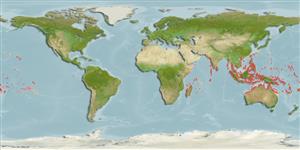Common names from other countries
Classification / Names / Names
Namen | Synonyme | Catalog of Fishes (gen., sp.) | ITIS | CoL | WoRMS
Environment: milieu / climate zone / depth range / distribution range
Ökologie
Riff-verbunden; tiefenbereich 0 - 5 m (Ref. 75835). Tropical; 31°N - 28°S, 42°E - 124°W
Indo-Pacific.
Length at first maturity / Size / Gewicht / Alter
Maturity: Lm ? range ? - ? cm Max length : 8.5 cm SHL Männchen/unbestimmt; (Ref. 821); common length : 5.0 cm SHL Männchen/unbestimmt; (Ref. 349); max. veröff. Alter: 3.00 Jahre (Ref. 117181)
One of the most frequently collected Turbinidae in the area, mainly for food. Shell also used as material for making buttons (Ref. 349). Sublittoral zone, in shallow water. Found in exposed areas of coral reefs (Ref. 349). Intertidal to 5 m, seaward on coral reefs (Ref. 75835). Herbivorous and detritus feeder (Ref. 107013).
Life cycle and mating behavior
Geschlechtsreife | Fortpflanzung | Ablaichen | Eier | Fecundity | Larven
Members of the order Patellogastropoda are mostly gonochoric and broadcast spawners. Life cycle: Embryos develop into planktonic trocophore larvae and later into juvenile veligers before becoming fully grown adults.
Poutiers, J.M. 1998. (Ref. 349)
IUCN Rote Liste Status (Ref. 130435)
CITES Status (Ref. 108899)
Not Evaluated
Not Evaluated
Bedrohung für Menschen
Harmless
Nutzung durch Menschen
Fischereien: kommerziell
| FishSource | Sea Around Us
Tools
Internet Quellen
Estimates based on models
Preferred temperature
(Ref.
115969): 25.6 - 29.3, mean 28.6 (based on 2967 cells).
Widerstandsfähigkeit
hoch, Verdopplung der Population dauert weniger als 15 Monate. (K=0.58; tmax=3).
Prior r = 1.19, 95% CL = 0.79 - 1.79, Based on 1 data-limited stock assessment.
Verwundbarkeit
Low vulnerability (10 of 100).
